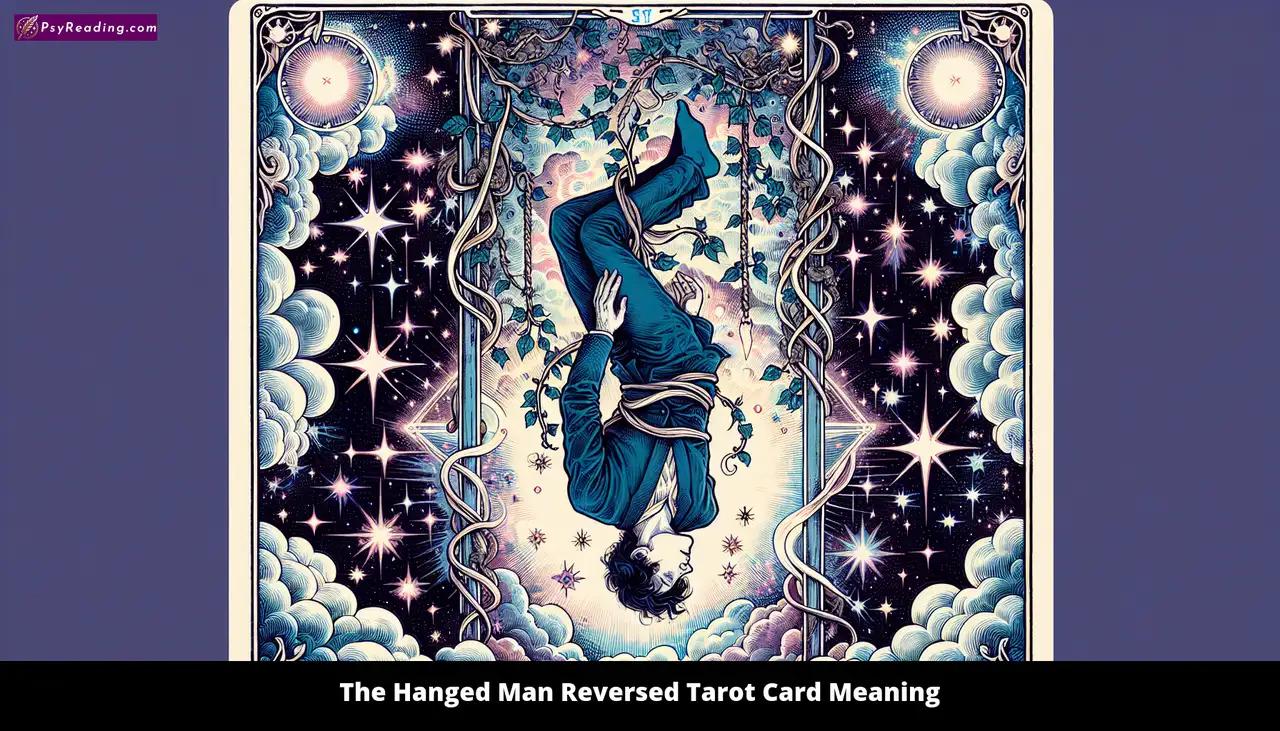The Hanged Man Reversed Tarot Card is a profound symbol imbued with complexity and paradox. In traditional tarot, the Hanged Man depicts a figure suspended upside down from one leg, embodying themes of surrender, reflection, and transformation. However, when this card appears reversed, its meaning shifts, revealing a kaleidoscope of insights and challenges that beckon the querent to delving deeper into their psyche.
At first glance, the reversed position of the Hanged Man suggests a resistance to the very themes of letting go and introspection that are inherent in its upright counterpart. Imagine a delicate pendulum swinging, poised on the brink of momentum; the reversed Hanged Man captures that moment of suspended possibility, where one is caught between the allure of action and the necessity of stillness. It conjures an experience rife with tension—a metaphorical tightrope walk where the seeker must confront their own aversion to release.
One of the most prominent interpretations of the Hanged Man reversed is a sense of stagnation. Those who draw this card may be grappling with feelings of entrapment or imprisonment within their own circumstances. The Hanged Man, in its traditional presentation, encourages the embrace of surrender as a form of active waiting, whereas in its reversed state, it can indicate a refusal to accept the need for patience. In this way, it illuminates the dangers of inaction, revealing how stubbornness can obstruct personal growth and enlightenment. Consider this: are you clinging to what is familiar yet unfulfilling, or are you truly ready to explore the uncharted territories of your own existence?
Additionally, the Hanged Man reversed often points towards a struggle with one’s perspective. It is a clarion call, urging the querent to recalibrate their vantage point in order to perceive their situation in a fresh light. The act of inversion—a key element of this card—is not merely about physical orientation but rather about challenging mental frameworks that may have become rigid over time. This card can serve as an invitation to seek new paradigms, akin to an artist stepping back from a canvas to see the overall composition rather than the intricate brushstrokes. It encourages a reevaluation of life’s priorities, urging individuals to transcend outdated narratives they may have been unwittingly tethered to.
The emotional landscape associated with the Hanged Man reversed can often be tumultuous. Here, resentment and frustration can bubble to the surface, acting as alarm bells signaling the need for change. Individuals may find themselves feeling disillusioned, wrestling with the discontent that arises when personal ambitions collide with external realities. The reversal suggests that the querent may be caught in a vortex of self-pity or negative thinking, ensnared by a malaise that seems to eclipse the brighter possibilities of life. This murmuring discontent is essential; it cradles the seeds of transformation, compelling the individual to confront their inner demons and emerge on the other side with renewed clarity.
In the realm of relationships, the Hanged Man reversed can signal miscommunication and discord. The metaphor of being ‘hung up’ becomes particularly poignant here; it reflects a state where both parties may be at an impasse, unable or unwilling to see the situation from the other’s perspective. This card can illuminate the self-imposed limitations that may be sabotaging the potential for intimacy and connection. One must ponder deeply: are you holding onto grievances or predefined notions that obstruct the flow of understanding? As the card implies, only by confronting these emotional somersaults can one untangle the web of connection and embark on a journey toward deeper and more honest interactions.
Conversely, the Hanged Man reversed can also represent the liberation that comes from breaking free of societal expectations or self-imposed constraints. It encourages explorations of individualism and authenticity, advocating for the courage to deviate from the norm. As the figure of the Hanged Man also resonates with the theme of martyrdom, this reversal may suggest that the querent is beginning to recognize the futility in sacrificing their own happiness in pursuit of others’ approval or validation. Here lies a pivotal juncture where one’s journey becomes about self-actualization rather than confinement—a transcendence from existential limitation.
Ultimately, the Hanged Man reversed is an invitation to initiate change—not merely by revamping external circumstances, but by embarking on an internal odyssey. It encapsulates a quintessential struggle faced by many: the tension between resignation and action, complacency and transformation. Like a butterfly emerging from a chrysalis, the silent metamorphosis invoked by the Hanged Man reversed encourages an alignment between intention and manifestation.
In conclusion, the essence of the Hanged Man reversed urges a confrontation with the profound layers of one’s existence. It challenges the seeker to embrace the paradox of inaction as a precursor to action, ultimately inviting introspection and a reappraisal of life’s guiding principles. The journey through this card necessitates a reckoning with one’s own beliefs, and it is within this labor of self-examination that true liberation can flourish. As such, the Hanged Man reversed stands as a bridge—a conduit between the cocooned sanctuary of the self and the vibrant world that lies beyond.









Leave a Comment